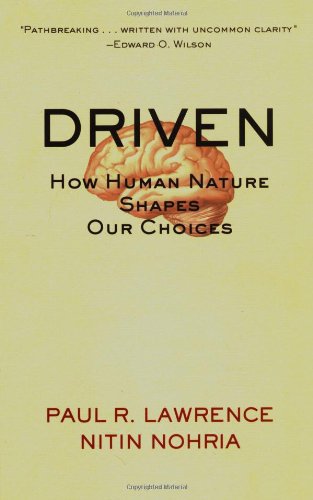 Driven: How Human Nature Shapes Our Choices is a book published in 2002 from the late Paul R. Lawrence and cohorts.
Driven: How Human Nature Shapes Our Choices is a book published in 2002 from the late Paul R. Lawrence and cohorts.
The purpose of Driven is to propose a unified theory of human behavior based on existing research across the various social sciences. It’s a tall order, but by the end of the book, an undeniably compelling case has been made. Or, an ordinary case has been made really well. It’s somewhat hard to say–he’s a pretty good writer.
Lawrence asserts that humans are moved by four independently operating drives, modules he sometimes calls them: The drive to Acquire, Bond, Learn and Defend.
“We propose that the four drives exist as hard-wired mental modules in the brains of all modern humans as primary drives, not derived from one another. This means that fulfilling one drive does not fulfill any of the others”
The individuality of each drive means our inner-state is often a complicated mental game of trade-offs. The drive to acquire, versus the drive to bond. The drive to Learn versus the drive to Defend. Emphasizing any one of them as supreme creates problems. In a cultural view, sole emphasis on the drive to Acquire looks like pure capitalism, sole emphasis on the drive to Bond looks like police-state communism.
Lawrence suggests the concept is seen clearly in the context of art, which is a phenomenon of our drive to Learn. Think about stories, they’re all about someone trying to bond with someone or something else, someone trying to get something that’s out of reach, someone just on the cusp of learning something new and important, or someone trying to defend what is important to them. Maybe it’s a little too broad to be compelling. But can you think of any others? I can’t, and that’s kind of his point.
In Lawrence’s view, social sciences tend to focus on the differences between people, without a lot of attention given to what makes us the same. A unified theory of this kind would naturally be extremely broad, and Lawrence and his team couldn’t narrow the list down any further.
“It may seem surprising that so few anthropologists have carefully pursued the question of cultural universals, but the truth is that the discipline, very early in history, became focused on the differences among cultures. This focus was consistent with the general doctrine of social sciences that human behavior is completely malleable to environmental influences. “
At several points throughout the book, Lawrence makes it clear that he does not claim his theory to be complete, and calls for more research.
As the book rounded the end, I found the discussion becoming a bit more philosophical than was really called for. But perhaps some good points are made. Unless we abandon the idea that human beings are a sole product of their environment, many obvious omissions in research will continue. He states that his theory does not predict how an individual human will respond in a specific situation. But rather that understanding the influence of each drive in relation to the others will be a long process of observation, and he shows us a lot of compelling information to suggest our researches should do just that.
In Conclusion
I really enjoyed the book. Obviously. Although he admits his theory is not complete, his suggestions almost seem like common sense. Any mindful person can observe the tension between these drives in their own life and behavior. I, for one, have become fascinated with the observation. He spent a considerable amount of time looking at the four drives in the context of an a couple of big organizations. This felt a little frivolous to me. But after everything else, the final chapter is clear and refreshing, in fact, you could probably just read that.

Recent Discussion